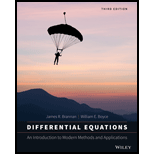
Each of Problems 1 through 6 can be interpreted as describeing the interaction of two species with populations
a) Draw a direction field and describe how solutions seem to behave.
b) Find the critical points.
c) For each critical points, find the corresponding linear sytem. Find the eigenvectors of the linear system, classify each critical points as to type, and determine whether it is asymototically stable, stable, or unstable.
d) Sketch thetrajectories in the neighbourhood of each critical points.
e) Compute and plot enough trajectories of the given system to show clearly the behaviour of the solutions.
f) Determine the limiting behaviour of
Trending nowThis is a popular solution!

Chapter 7 Solutions
Differential Equations: An Introduction to Modern Methods and Applications
Additional Math Textbook Solutions
A First Course in Probability (10th Edition)
Elementary Statistics (13th Edition)
A Problem Solving Approach To Mathematics For Elementary School Teachers (13th Edition)
Probability And Statistical Inference (10th Edition)
Elementary Statistics
- Find the area of the figure. A = 4 m 11 m 13 m 5 marrow_forwardFind the exact values of sin(2u), cos(2u), and tan(2u) given 2 COS u where д < u < π. 2arrow_forward(1) Let R be a field of real numbers and X=R³, X is a vector space over R, let M={(a,b,c)/ a,b,cE R,a+b=3-c}, show that whether M is a hyperplane of X or not (not by definition). متکاری Xn-XKE 11Xn- Xmit (2) Show that every converge sequence in a normed space is Cauchy sequence but the converse need not to be true. EK 2x7 (3) Write the definition of continuous map between two normed spaces and write with prove the equivalent statement to definition. (4) Let be a subset of a normed space X over a field F, show that A is bounded set iff for any sequence in A and any sequence in F converge to zero the sequence converge to zero in F. އarrow_forward
- Algebra & Trigonometry with Analytic GeometryAlgebraISBN:9781133382119Author:SwokowskiPublisher:Cengage
